Leadership and Management Report: Mercadona Case Study Analysis
VerifiedAdded on 2021/02/22
|6
|1367
|103
Report
AI Summary
This report provides a detailed analysis of leadership and management principles, encompassing strategic leadership, motivational theories, and team development. It explores various leadership and management theories, including situational leadership and contingency management, and examines the challenges faced by leaders, such as maintaining honesty and integrity. The report delves into motivational theories like Herzberg's Two-Factor Theory and Maslow's Hierarchy of Needs, illustrating their application through the case study of Mercadona, a supermarket chain. It also discusses the role of performance management and analyzes team development models like Tuckman's and Hill's models, highlighting the importance of team leadership and its impact on organizational performance. The report emphasizes the significance of effective leadership and management in driving employee motivation, fostering team collaboration, and achieving organizational goals. The report concludes with a summary of the concepts and theories discussed, highlighting Mercadona's application of these principles to achieve its business objectives.
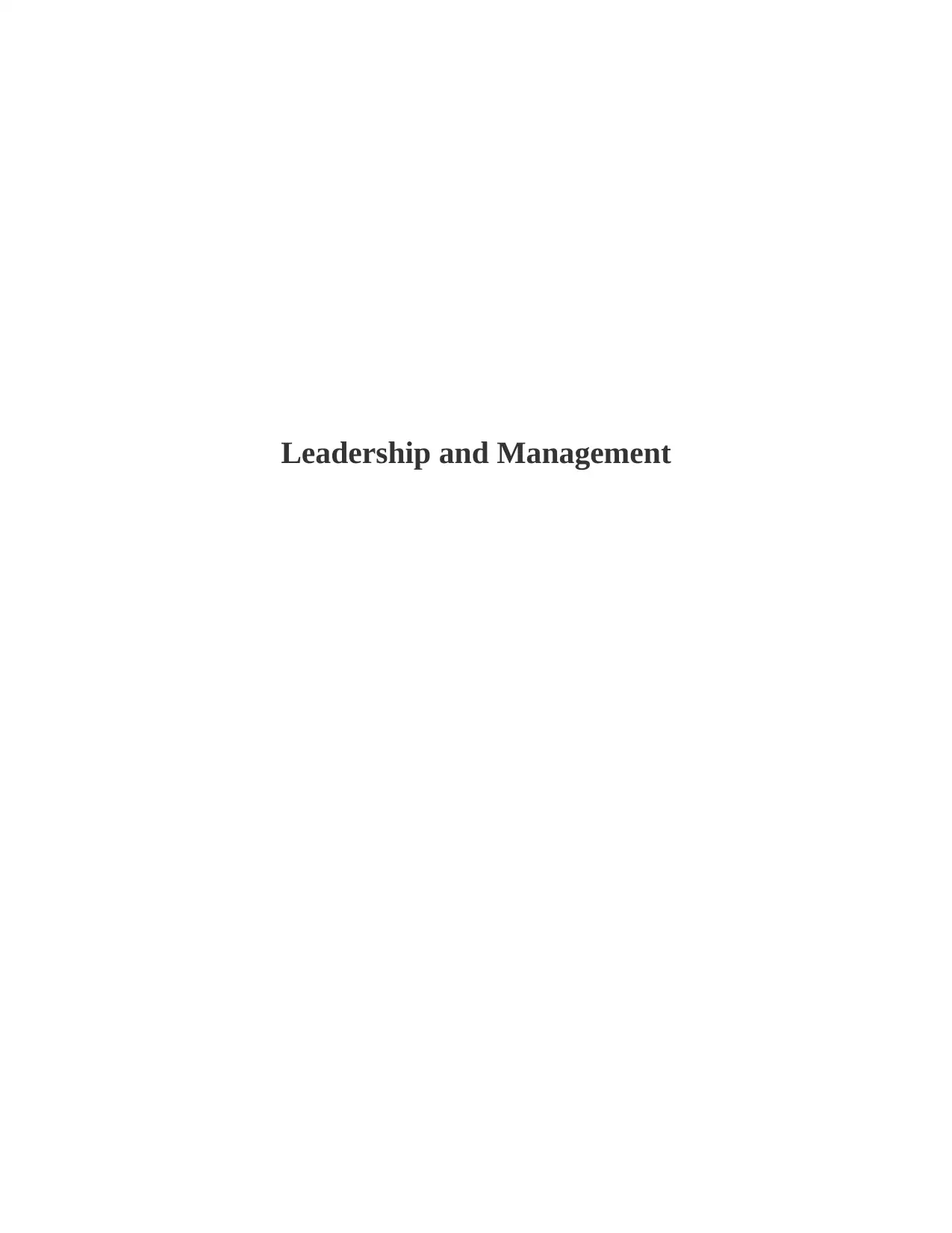
Leadership and Management
Paraphrase This Document
Need a fresh take? Get an instant paraphrase of this document with our AI Paraphraser
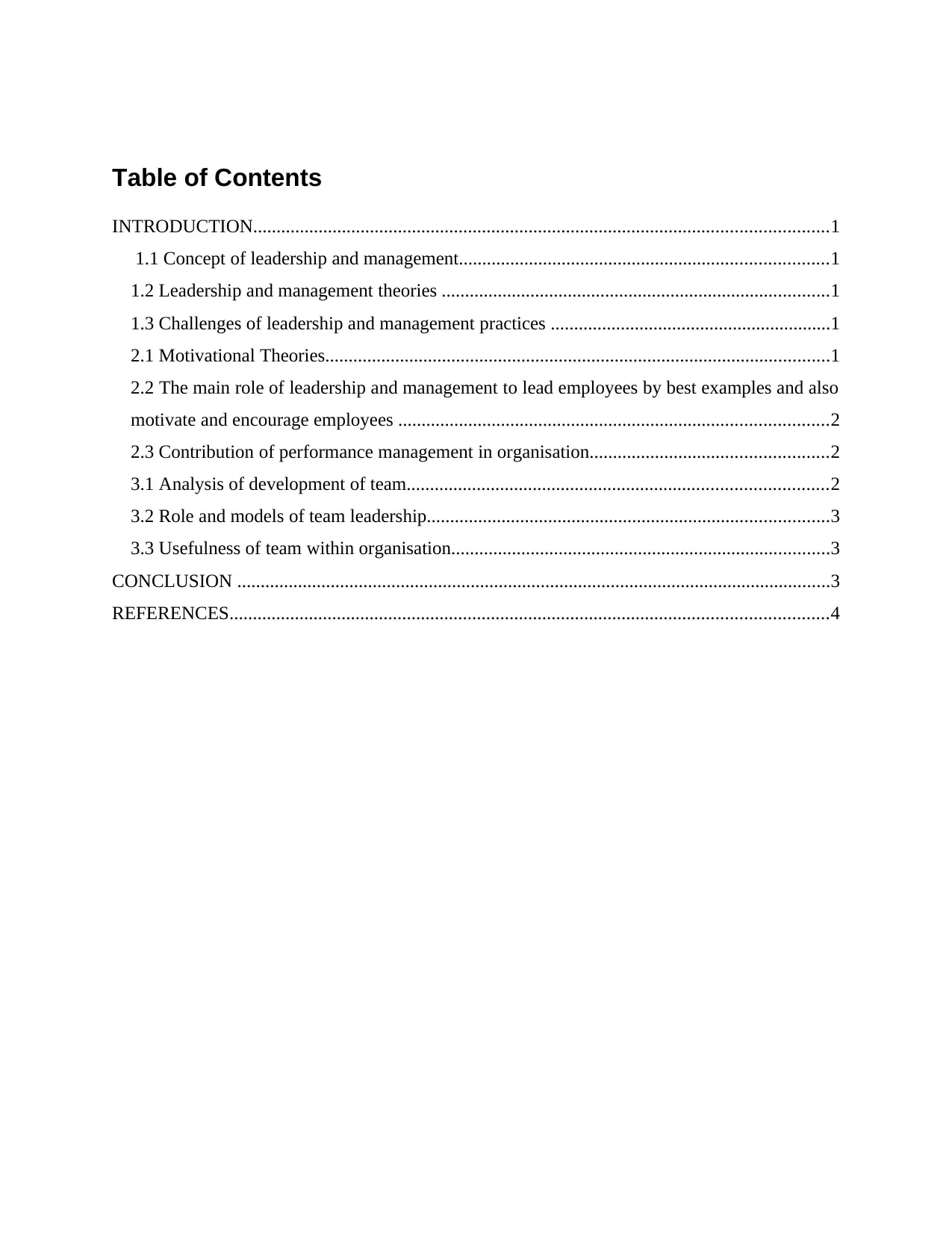
Table of Contents
INTRODUCTION...........................................................................................................................1
1.1 Concept of leadership and management...............................................................................1
1.2 Leadership and management theories ...................................................................................1
1.3 Challenges of leadership and management practices ............................................................1
2.1 Motivational Theories............................................................................................................1
2.2 The main role of leadership and management to lead employees by best examples and also
motivate and encourage employees ............................................................................................2
2.3 Contribution of performance management in organisation...................................................2
3.1 Analysis of development of team..........................................................................................2
3.2 Role and models of team leadership......................................................................................3
3.3 Usefulness of team within organisation.................................................................................3
CONCLUSION ...............................................................................................................................3
REFERENCES................................................................................................................................4
INTRODUCTION...........................................................................................................................1
1.1 Concept of leadership and management...............................................................................1
1.2 Leadership and management theories ...................................................................................1
1.3 Challenges of leadership and management practices ............................................................1
2.1 Motivational Theories............................................................................................................1
2.2 The main role of leadership and management to lead employees by best examples and also
motivate and encourage employees ............................................................................................2
2.3 Contribution of performance management in organisation...................................................2
3.1 Analysis of development of team..........................................................................................2
3.2 Role and models of team leadership......................................................................................3
3.3 Usefulness of team within organisation.................................................................................3
CONCLUSION ...............................................................................................................................3
REFERENCES................................................................................................................................4
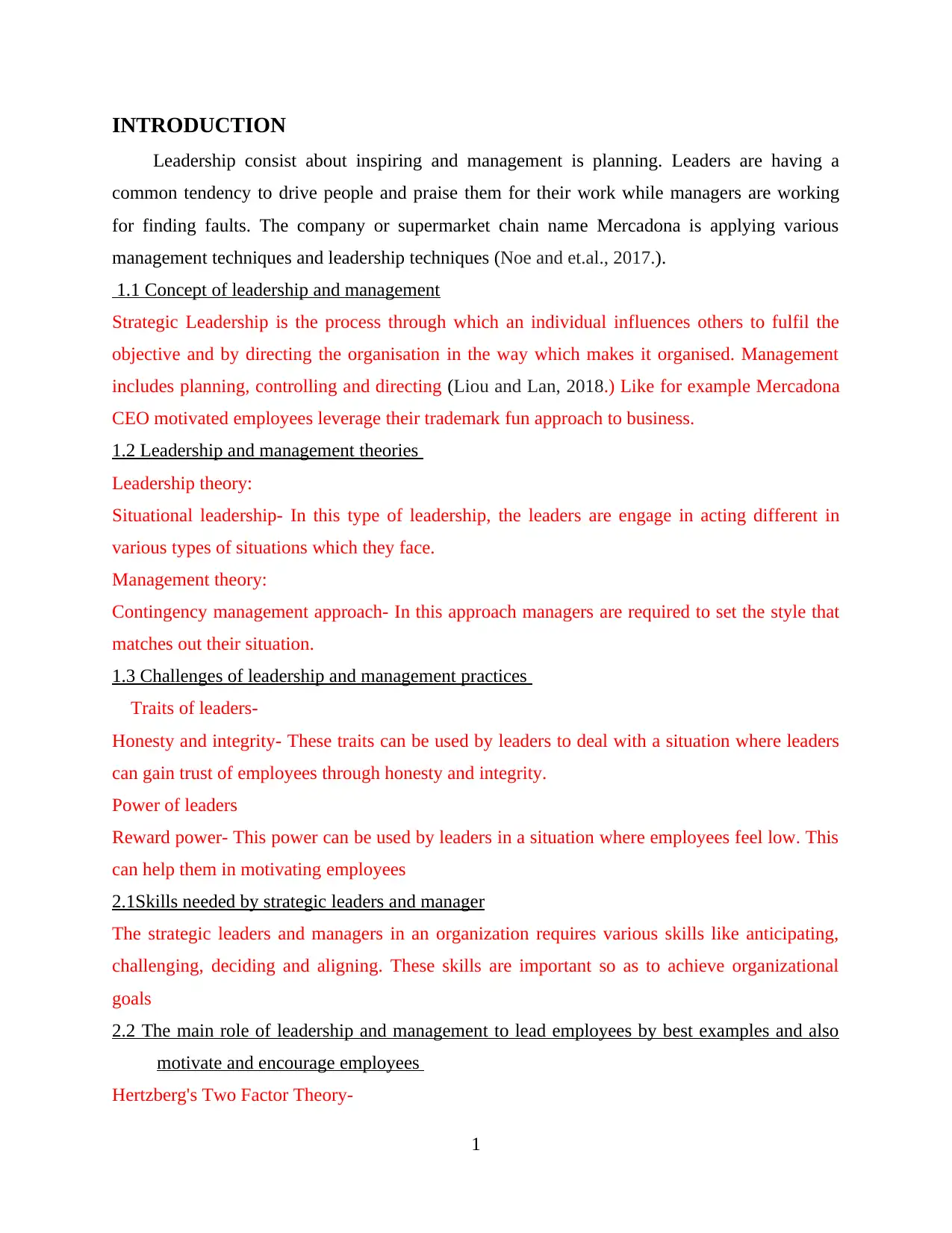
INTRODUCTION
Leadership consist about inspiring and management is planning. Leaders are having a
common tendency to drive people and praise them for their work while managers are working
for finding faults. The company or supermarket chain name Mercadona is applying various
management techniques and leadership techniques (Noe and et.al., 2017.).
1.1 Concept of leadership and management
Strategic Leadership is the process through which an individual influences others to fulfil the
objective and by directing the organisation in the way which makes it organised. Management
includes planning, controlling and directing (Liou and Lan, 2018.) Like for example Mercadona
CEO motivated employees leverage their trademark fun approach to business.
1.2 Leadership and management theories
Leadership theory:
Situational leadership- In this type of leadership, the leaders are engage in acting different in
various types of situations which they face.
Management theory:
Contingency management approach- In this approach managers are required to set the style that
matches out their situation.
1.3 Challenges of leadership and management practices
Traits of leaders-
Honesty and integrity- These traits can be used by leaders to deal with a situation where leaders
can gain trust of employees through honesty and integrity.
Power of leaders
Reward power- This power can be used by leaders in a situation where employees feel low. This
can help them in motivating employees
2.1Skills needed by strategic leaders and manager
The strategic leaders and managers in an organization requires various skills like anticipating,
challenging, deciding and aligning. These skills are important so as to achieve organizational
goals
2.2 The main role of leadership and management to lead employees by best examples and also
motivate and encourage employees
Hertzberg's Two Factor Theory-
1
Leadership consist about inspiring and management is planning. Leaders are having a
common tendency to drive people and praise them for their work while managers are working
for finding faults. The company or supermarket chain name Mercadona is applying various
management techniques and leadership techniques (Noe and et.al., 2017.).
1.1 Concept of leadership and management
Strategic Leadership is the process through which an individual influences others to fulfil the
objective and by directing the organisation in the way which makes it organised. Management
includes planning, controlling and directing (Liou and Lan, 2018.) Like for example Mercadona
CEO motivated employees leverage their trademark fun approach to business.
1.2 Leadership and management theories
Leadership theory:
Situational leadership- In this type of leadership, the leaders are engage in acting different in
various types of situations which they face.
Management theory:
Contingency management approach- In this approach managers are required to set the style that
matches out their situation.
1.3 Challenges of leadership and management practices
Traits of leaders-
Honesty and integrity- These traits can be used by leaders to deal with a situation where leaders
can gain trust of employees through honesty and integrity.
Power of leaders
Reward power- This power can be used by leaders in a situation where employees feel low. This
can help them in motivating employees
2.1Skills needed by strategic leaders and manager
The strategic leaders and managers in an organization requires various skills like anticipating,
challenging, deciding and aligning. These skills are important so as to achieve organizational
goals
2.2 The main role of leadership and management to lead employees by best examples and also
motivate and encourage employees
Hertzberg's Two Factor Theory-
1
⊘ This is a preview!⊘
Do you want full access?
Subscribe today to unlock all pages.

Trusted by 1+ million students worldwide
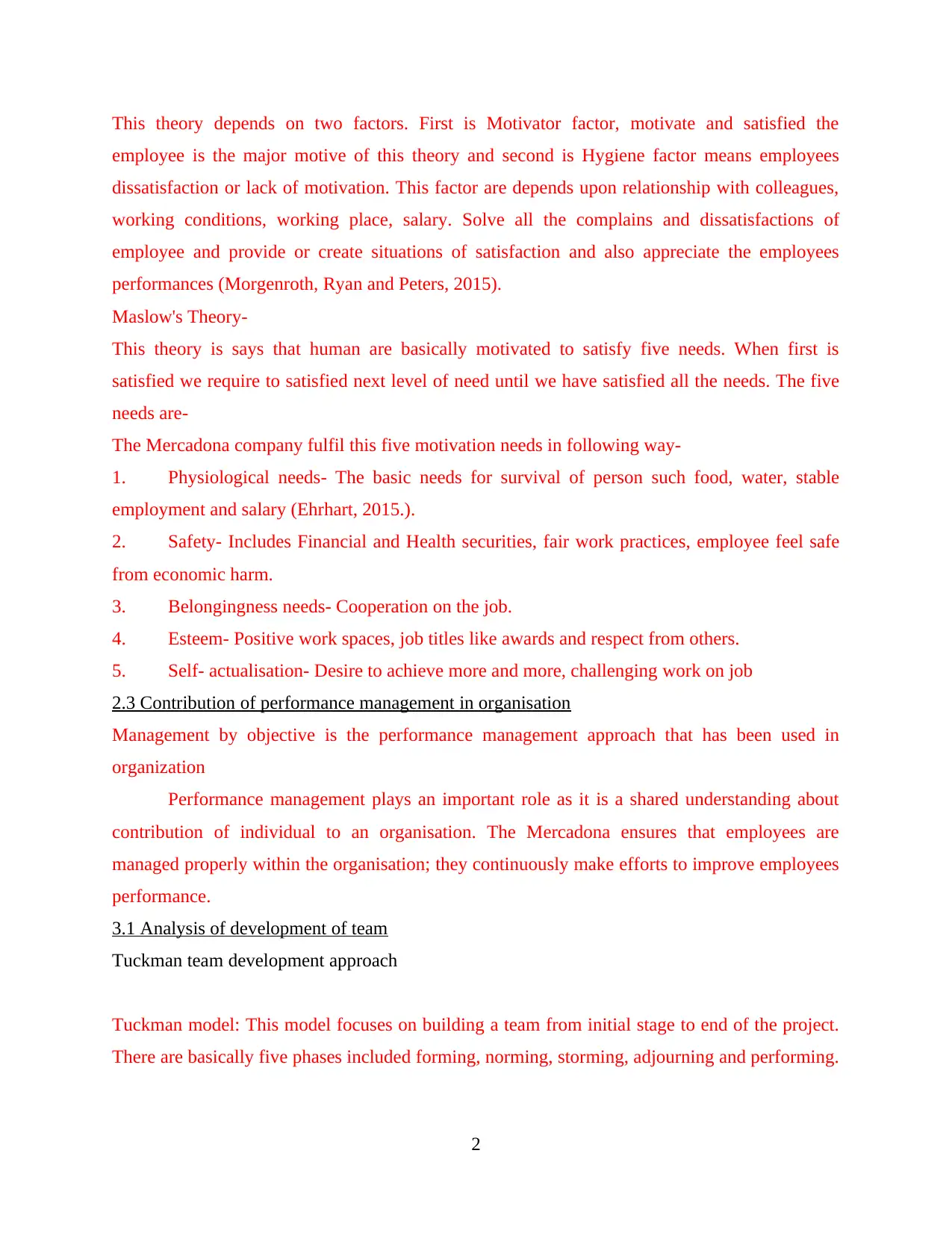
This theory depends on two factors. First is Motivator factor, motivate and satisfied the
employee is the major motive of this theory and second is Hygiene factor means employees
dissatisfaction or lack of motivation. This factor are depends upon relationship with colleagues,
working conditions, working place, salary. Solve all the complains and dissatisfactions of
employee and provide or create situations of satisfaction and also appreciate the employees
performances (Morgenroth, Ryan and Peters, 2015).
Maslow's Theory-
This theory is says that human are basically motivated to satisfy five needs. When first is
satisfied we require to satisfied next level of need until we have satisfied all the needs. The five
needs are-
The Mercadona company fulfil this five motivation needs in following way-
1. Physiological needs- The basic needs for survival of person such food, water, stable
employment and salary (Ehrhart, 2015.).
2. Safety- Includes Financial and Health securities, fair work practices, employee feel safe
from economic harm.
3. Belongingness needs- Cooperation on the job.
4. Esteem- Positive work spaces, job titles like awards and respect from others.
5. Self- actualisation- Desire to achieve more and more, challenging work on job
2.3 Contribution of performance management in organisation
Management by objective is the performance management approach that has been used in
organization
Performance management plays an important role as it is a shared understanding about
contribution of individual to an organisation. The Mercadona ensures that employees are
managed properly within the organisation; they continuously make efforts to improve employees
performance.
3.1 Analysis of development of team
Tuckman team development approach
Tuckman model: This model focuses on building a team from initial stage to end of the project.
There are basically five phases included forming, norming, storming, adjourning and performing.
2
employee is the major motive of this theory and second is Hygiene factor means employees
dissatisfaction or lack of motivation. This factor are depends upon relationship with colleagues,
working conditions, working place, salary. Solve all the complains and dissatisfactions of
employee and provide or create situations of satisfaction and also appreciate the employees
performances (Morgenroth, Ryan and Peters, 2015).
Maslow's Theory-
This theory is says that human are basically motivated to satisfy five needs. When first is
satisfied we require to satisfied next level of need until we have satisfied all the needs. The five
needs are-
The Mercadona company fulfil this five motivation needs in following way-
1. Physiological needs- The basic needs for survival of person such food, water, stable
employment and salary (Ehrhart, 2015.).
2. Safety- Includes Financial and Health securities, fair work practices, employee feel safe
from economic harm.
3. Belongingness needs- Cooperation on the job.
4. Esteem- Positive work spaces, job titles like awards and respect from others.
5. Self- actualisation- Desire to achieve more and more, challenging work on job
2.3 Contribution of performance management in organisation
Management by objective is the performance management approach that has been used in
organization
Performance management plays an important role as it is a shared understanding about
contribution of individual to an organisation. The Mercadona ensures that employees are
managed properly within the organisation; they continuously make efforts to improve employees
performance.
3.1 Analysis of development of team
Tuckman team development approach
Tuckman model: This model focuses on building a team from initial stage to end of the project.
There are basically five phases included forming, norming, storming, adjourning and performing.
2
Paraphrase This Document
Need a fresh take? Get an instant paraphrase of this document with our AI Paraphraser
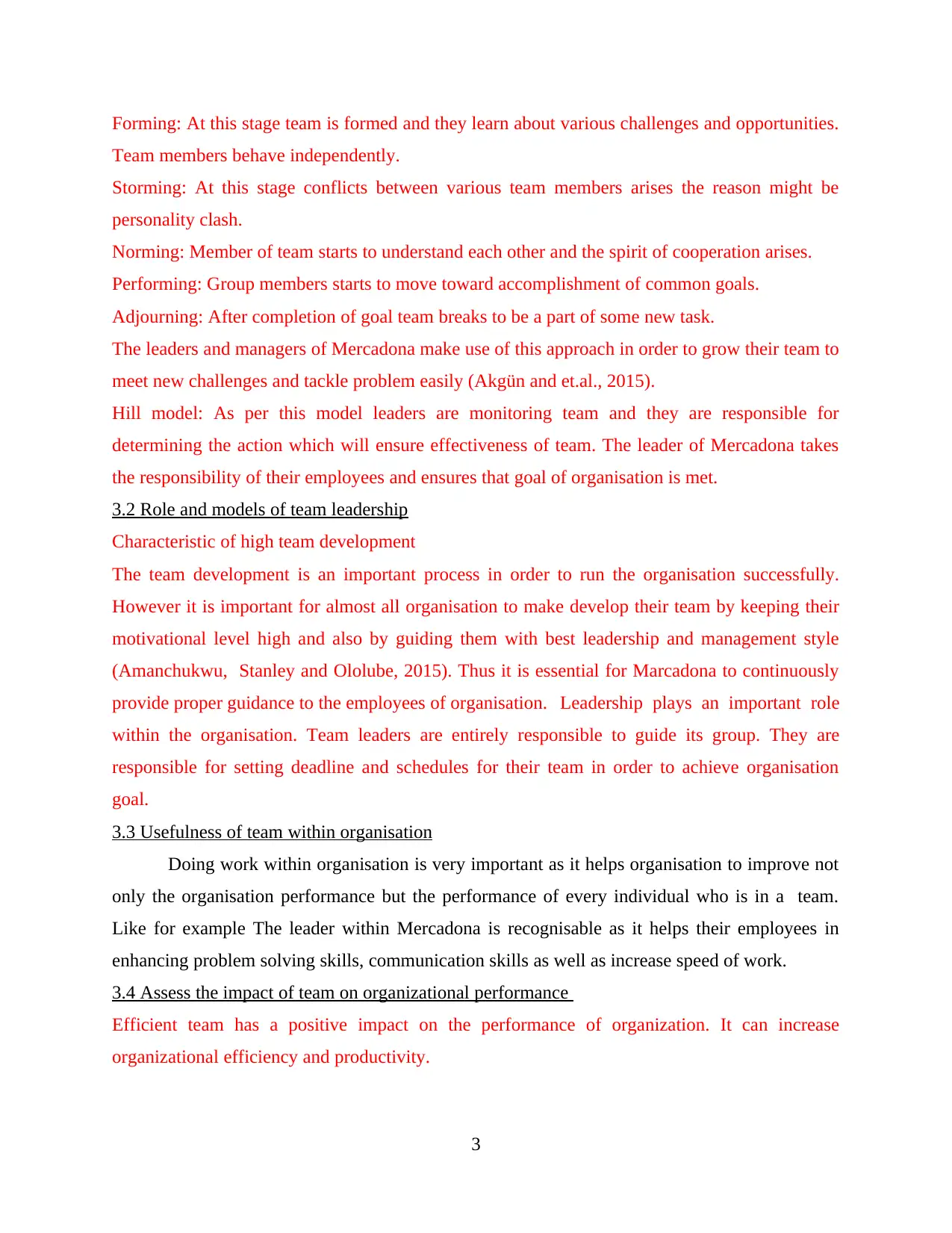
Forming: At this stage team is formed and they learn about various challenges and opportunities.
Team members behave independently.
Storming: At this stage conflicts between various team members arises the reason might be
personality clash.
Norming: Member of team starts to understand each other and the spirit of cooperation arises.
Performing: Group members starts to move toward accomplishment of common goals.
Adjourning: After completion of goal team breaks to be a part of some new task.
The leaders and managers of Mercadona make use of this approach in order to grow their team to
meet new challenges and tackle problem easily (Akgün and et.al., 2015).
Hill model: As per this model leaders are monitoring team and they are responsible for
determining the action which will ensure effectiveness of team. The leader of Mercadona takes
the responsibility of their employees and ensures that goal of organisation is met.
3.2 Role and models of team leadership
Characteristic of high team development
The team development is an important process in order to run the organisation successfully.
However it is important for almost all organisation to make develop their team by keeping their
motivational level high and also by guiding them with best leadership and management style
(Amanchukwu, Stanley and Ololube, 2015). Thus it is essential for Marcadona to continuously
provide proper guidance to the employees of organisation. Leadership plays an important role
within the organisation. Team leaders are entirely responsible to guide its group. They are
responsible for setting deadline and schedules for their team in order to achieve organisation
goal.
3.3 Usefulness of team within organisation
Doing work within organisation is very important as it helps organisation to improve not
only the organisation performance but the performance of every individual who is in a team.
Like for example The leader within Mercadona is recognisable as it helps their employees in
enhancing problem solving skills, communication skills as well as increase speed of work.
3.4 Assess the impact of team on organizational performance
Efficient team has a positive impact on the performance of organization. It can increase
organizational efficiency and productivity.
3
Team members behave independently.
Storming: At this stage conflicts between various team members arises the reason might be
personality clash.
Norming: Member of team starts to understand each other and the spirit of cooperation arises.
Performing: Group members starts to move toward accomplishment of common goals.
Adjourning: After completion of goal team breaks to be a part of some new task.
The leaders and managers of Mercadona make use of this approach in order to grow their team to
meet new challenges and tackle problem easily (Akgün and et.al., 2015).
Hill model: As per this model leaders are monitoring team and they are responsible for
determining the action which will ensure effectiveness of team. The leader of Mercadona takes
the responsibility of their employees and ensures that goal of organisation is met.
3.2 Role and models of team leadership
Characteristic of high team development
The team development is an important process in order to run the organisation successfully.
However it is important for almost all organisation to make develop their team by keeping their
motivational level high and also by guiding them with best leadership and management style
(Amanchukwu, Stanley and Ololube, 2015). Thus it is essential for Marcadona to continuously
provide proper guidance to the employees of organisation. Leadership plays an important role
within the organisation. Team leaders are entirely responsible to guide its group. They are
responsible for setting deadline and schedules for their team in order to achieve organisation
goal.
3.3 Usefulness of team within organisation
Doing work within organisation is very important as it helps organisation to improve not
only the organisation performance but the performance of every individual who is in a team.
Like for example The leader within Mercadona is recognisable as it helps their employees in
enhancing problem solving skills, communication skills as well as increase speed of work.
3.4 Assess the impact of team on organizational performance
Efficient team has a positive impact on the performance of organization. It can increase
organizational efficiency and productivity.
3
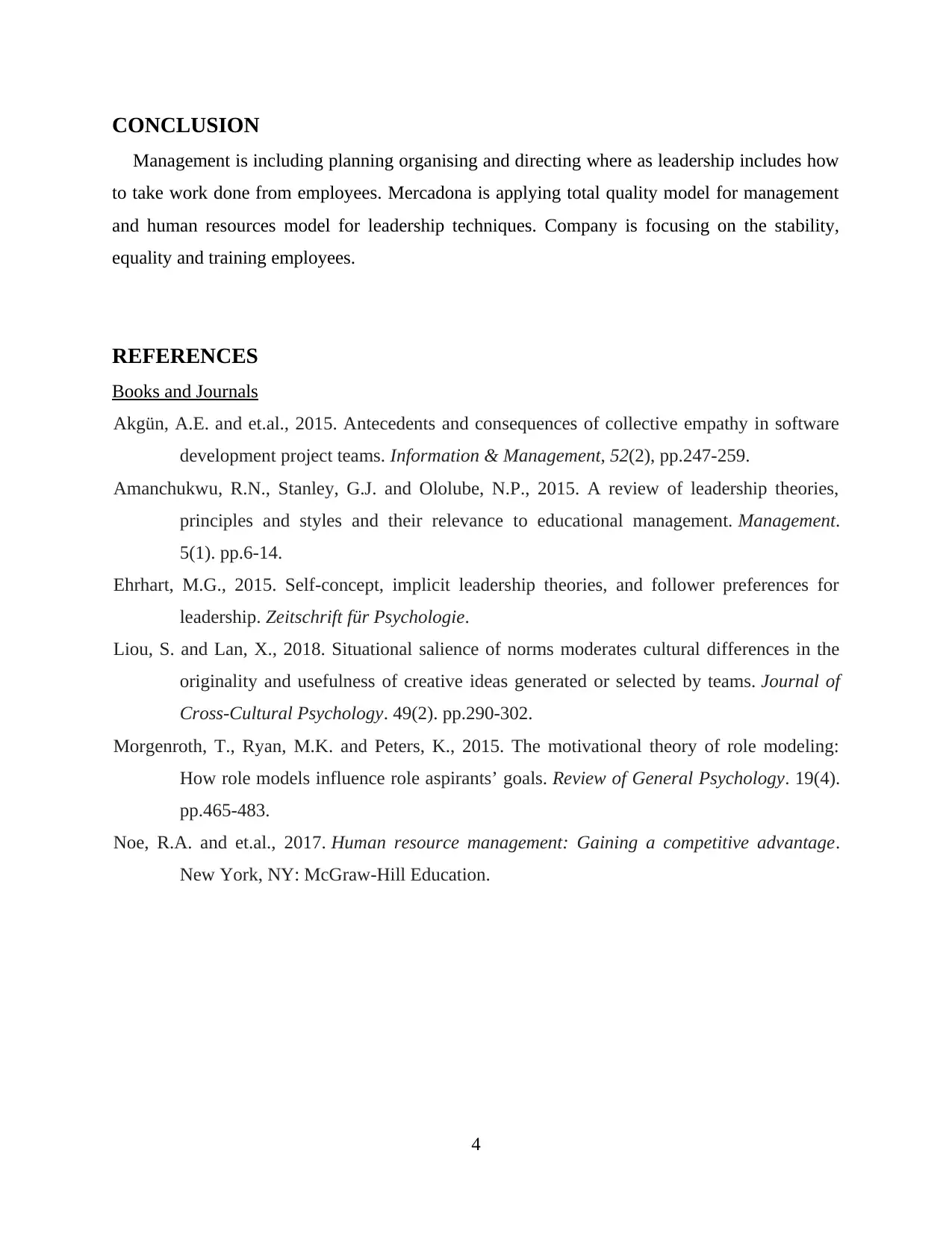
CONCLUSION
Management is including planning organising and directing where as leadership includes how
to take work done from employees. Mercadona is applying total quality model for management
and human resources model for leadership techniques. Company is focusing on the stability,
equality and training employees.
REFERENCES
Books and Journals
Akgün, A.E. and et.al., 2015. Antecedents and consequences of collective empathy in software
development project teams. Information & Management, 52(2), pp.247-259.
Amanchukwu, R.N., Stanley, G.J. and Ololube, N.P., 2015. A review of leadership theories,
principles and styles and their relevance to educational management. Management.
5(1). pp.6-14.
Ehrhart, M.G., 2015. Self-concept, implicit leadership theories, and follower preferences for
leadership. Zeitschrift für Psychologie.
Liou, S. and Lan, X., 2018. Situational salience of norms moderates cultural differences in the
originality and usefulness of creative ideas generated or selected by teams. Journal of
Cross-Cultural Psychology. 49(2). pp.290-302.
Morgenroth, T., Ryan, M.K. and Peters, K., 2015. The motivational theory of role modeling:
How role models influence role aspirants’ goals. Review of General Psychology. 19(4).
pp.465-483.
Noe, R.A. and et.al., 2017. Human resource management: Gaining a competitive advantage.
New York, NY: McGraw-Hill Education.
4
Management is including planning organising and directing where as leadership includes how
to take work done from employees. Mercadona is applying total quality model for management
and human resources model for leadership techniques. Company is focusing on the stability,
equality and training employees.
REFERENCES
Books and Journals
Akgün, A.E. and et.al., 2015. Antecedents and consequences of collective empathy in software
development project teams. Information & Management, 52(2), pp.247-259.
Amanchukwu, R.N., Stanley, G.J. and Ololube, N.P., 2015. A review of leadership theories,
principles and styles and their relevance to educational management. Management.
5(1). pp.6-14.
Ehrhart, M.G., 2015. Self-concept, implicit leadership theories, and follower preferences for
leadership. Zeitschrift für Psychologie.
Liou, S. and Lan, X., 2018. Situational salience of norms moderates cultural differences in the
originality and usefulness of creative ideas generated or selected by teams. Journal of
Cross-Cultural Psychology. 49(2). pp.290-302.
Morgenroth, T., Ryan, M.K. and Peters, K., 2015. The motivational theory of role modeling:
How role models influence role aspirants’ goals. Review of General Psychology. 19(4).
pp.465-483.
Noe, R.A. and et.al., 2017. Human resource management: Gaining a competitive advantage.
New York, NY: McGraw-Hill Education.
4
⊘ This is a preview!⊘
Do you want full access?
Subscribe today to unlock all pages.

Trusted by 1+ million students worldwide
1 out of 6
Related Documents
Your All-in-One AI-Powered Toolkit for Academic Success.
+13062052269
info@desklib.com
Available 24*7 on WhatsApp / Email
![[object Object]](/_next/static/media/star-bottom.7253800d.svg)
Unlock your academic potential
Copyright © 2020–2025 A2Z Services. All Rights Reserved. Developed and managed by ZUCOL.





